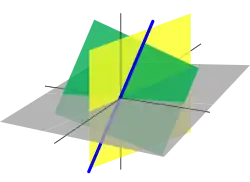Multilinear algebra
Multilinear algebra is a subfield of mathematics that extends the methods of linear algebra. Just as linear algebra builds on the concept of a vector and develops the theory of vector spaces, multilinear algebra builds on the concepts of p-vectors and multivectors with Grassmann algebras.
Origin
In a vector space of dimension n, vectors are used in most cases. However, according to Hermann Grassmann and others, this presumption misses the complexity of considering the structures of pairs, triplets, and general multi-vectors. With several combinatorial possibilities, the space of multi-vectors has 2n dimensions.[1] The abstract formulation of the determinant is the most immediate application. Multi-linear algebra also has applications in the mechanical study of material response to stress and strain with various moduli of elasticity. This practical reference led to the use of the word tensor, to describe the elements of the multi-linear space. The extra structure in a multi-linear space has led it to play an important role in various studies in higher mathematics. Though Grassmann started the subject in 1844 with his Ausdehnungslehre, which was also republished in 1862, his work was to find acceptance, as ordinary linear algebra provided sufficient challenges to comprehension.
The topic of multilinear algebra is applied in some studies of multivariate calculus and manifolds where the Jacobian matrix comes into play. The infinitesimal differentials of single variable calculus become differential forms in multivariate calculus, and their manipulation is done with exterior algebra.[2]
After Grassmann, developments in multilinear algebra were made in 1872 by Victor Schlegel when he published the first part of his System der Raumlehre, and by Elwin Bruno Christoffel. A major advance in multilinear algebra came in the work of Gregorio Ricci-Curbastro and Tullio Levi-Civita.[3] It was the absolute differential calculus form of multilinear algebra that Marcel Grossmann and Michele Besso introduced to Albert Einstein. The publication in 1915 by Einstein of general relativity explaining the precession of the perihelion of Mercury established multilinear algebra and tensors as important mathematics in physics.
In 1958 Nicolas Bourbaki published Algèbra Multilinéair as chapter 3 of Algèbra in the series Éléments de mathématique. The book begins with bilinear functions, tensor product of two modules, and properties of tensor products.[4]
Topics in multilinear algebra
The subject matter of multilinear algebra has evolved less than the presentation down the years. Here are further pages centrally relevant to it:
- Closed and exact differential forms
- Component-free treatment of tensors
- Cramer's rule
- Dual space
- Einstein notation
- Exterior algebra
- Inner product
- Kronecker delta
- Levi-Civita symbol
- Metric tensor
- Mixed tensor
- Multilinear form
- Symmetric algebra, Symmetric power
- Symmetric tensor
- Tensor
- Tensor algebra, Free algebra
- Tensor contraction
There is also a glossary of tensor theory.
Applications
Some of the ways in which multilinear algebra concepts are applied:
References
- Grassmann, Hermann (2000) [1862]. Extension Theory [Die Ausdehnungslehre]. Translated by Kannenberg, Lloyd. American Mathematical Society. ISBN 978-0-8218-9049-3.
- Fleming, Wendell H. (1977). "Exterior algebra and differential calculus". Functions of several variables. Undergraduate Texts in Mathematics (2nd ed.). Springer. pp. 275–320. doi:10.1007/978-1-4684-9461-7_7. ISBN 978-1-4684-9461-7. OCLC 2401829.
- Ricci-Curbastro, Gregorio; Levi-Civita, Tullio (1900). "Méthodes de calcul différentiel absolu et leurs applications". Mathematische Annalen. 54 (1): 125–201. doi:10.1007/BF01454201. ISSN 1432-1807. S2CID 120009332.
- Nicolas Bourbaki (1958) Algèbra Multilinéair, chapter 3 of book 2 Algebra, in Éléments de mathématique, Paris: Hermann
- Greub, W. H. (1967) Multilinear Algebra, Springer
- Douglas Northcott (1984) Multilinear Algebra, Cambridge University Press ISBN 0-521-26269-0
- Shaw, Ronald (1983). Multilinear algebra and group representations. Linear Algebra and Group Representations. Vol. 2. Academic Press. ISBN 978-0-12-639202-9. OCLC 59106339.
